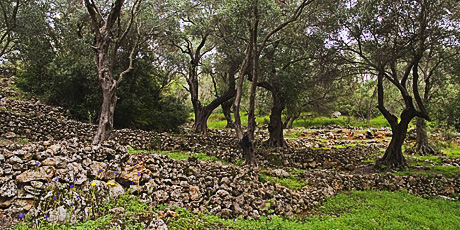 Olive grove. |
|
| Olive: - The present day olive tree is thought to have been cultivated from the Oleaster bush about 3500BC in Crete and Syria simultaneously. Thereafter it rapidly spread throughout the region due to its culinary and economic value. Cultivation methods vary slightly in the different regions and on Corfu the trees are not pruned and are therefore much larger than elsewhere. Many of the trees are hundreds of years old with some reputed to be up to six hundred years. Some are virtually hollow due to their knarled and distorted trunks. Today olive groves cover more than 40% of the island. Here the fruit is left to mature on the tree until it falls naturally as this is said to increase the value of the oil. Other Mediterranean areas use mechanical tree shakers or beat/comb the fruit from the trees. The fruit is harvested with large black nets spread beneath each tree from November to April. Once gathered the olives are brought to the olive press where they are crushed and then the oil is extracted from the paste by mechanical means followed by filtration to remove any remaining particles. Olive oil is the only oil that can be consumed without any further processing once extracted from the fruit. Olive oil is extremely beneficial for the cardio vascular system, which is evident in the longevity of many Corfiot residents. The olive fruit fly, which is by far the greatest threat to the olive crop, has been the subject of much debate especially regarding its eradication as on Corfu and most other countries this has been done to date using helicopters to aerial spray insecticides. This has led to uneasiness regarding the long-term effects of these insecticides on both the human population and the beneficial insects of the island and ultimately the food chain. Recently a comprehensive study of the olive fruit fly was carried out by Scientists Fletcher and Kapatos in unsprayed olive groves on Corfu, which has led to a better understanding of the population ecology of the olive fruit fly. This study in turn has helped worldwide development of alternative methods of control most notably Pheromone traps, which are now the only allowable method of control in some areas of Corfu.
|
|
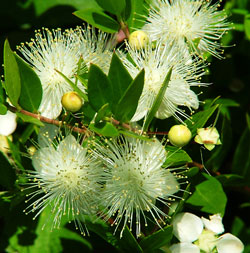 Myrtle |
Myrtle: - There are many Greek legends concerning the myrtle bush. One of them tells of a nymph called Mirsine who raced against the goddess Athena and won. Athena, in a rage then killed Mirsine whose body was transformed into a beautiful myrtle bush. In mythology there are also close associations with the Roman goddess Venus and the Greek goddess Aphrodite. So it is not surprising that in Greek culture this plant has close associations with love marriage and death. Branches and flowers are still used in wedding bouquets and in classical times poets and renowned thinkers wore wreaths of Myrtle. The leaves and flowers contain scented oil, which is used in the perfume industry. |
| The leaves are also used
as a herb when cooking meat and fish. Myrtle is a fast
growing low bush, usually about 3 to 4 feet high. It is
widespread throughout Corfu. |
|
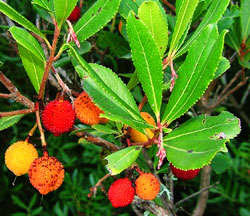 Strawberry tree |
The Strawberry Tree: - Has dark green leaves and beige coloured bottle like flowers, its fruit resembles strawberries and ripen from green to yellow to vivid red. It is a member of the Heather family (ericaceae). This plant can live for up to a thousand years where older stems are replaced with new growth from its flattened woody base, which is called a Lignotuber. The Strawberry tree is native to Mediterranean countries and also some milder Atlantic coasts such as western Ireland although it has been decimated in these areas where it was used to make charcoal for iron smelting. It is fortunately still quite common on Corfu. |
|
The fruit is edible with a delicate flavour and is used in
liquors and jam making. The Two Tailed Pasha butterfly
uses the Strawberry tree as a host for its eggs and
caterpillars.
|
|
 Eucalyptus |
Eucalyptus: - An occasional sight on the island. It is easily recognisable by its long leaves and peeling pastel coloured rust and cream bark. Eucalyptus trees are amongst the largest trees to be found on Corfu. In the 19th century they were commonly known as “Fever Trees” due to their miraculous ability to reduce the number of cases of malaria in the vicinity. Malaria from the Italian “Male Aria” literally “ bad air” was believed to be an illness caused primarily by living in an area close to swamps or marshland and the associated smells from the stagnant water. The Eucalyptus is fast growing and has the ability to absorb large quantities of water, which then evaporates through the leaves thereby helping to dry the land. The pleasing smell of eucalyptus helped to alleviate any pungent odours and it is thought the leaves in the water made the environment unsuitable for mosquito larvae. |
|
Judas tree |
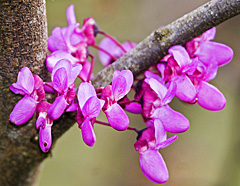 Judas tree flowers |
| Judas Tree: - So named because it is from this type of tree that Judas is said to have hanged himself after he betrayed Jesus, therefore it is said to blush with shame ever since with a display of pink (magenta) flowers on the trunk and stems before the leaves appear in spring, it flowers from march to April, the flowers have 2 larger lower petals and 3 erect upper petals and it has bright green circular leaves. This plant is from the same family as peas or legumes. |
|
 Fig |
Fig:- Usually found near habitation, they have large indented leaves and fruit in the summer months .Fig have been cultivated as far back as 7000B.C. in Jerico and is the first tree to be mentioned in the bible. Originally from Caria in Asia Minor, hence its scientific name of Ficus Carica. The Fig tree is unusual in that it doesn’t have a resinous sap instead it exudes a slightly caustic milky substance when cut. It is very deep-rooted and able to withstand extreme drought, also its wood is very porous and retains large reserves of moisture. Fig does not flower and fruit like a normal tree instead it actually flowers inwardly and the fruit is really the flowers, full of stamens etc.
|
 Kermes oak |
Kermes oak: - (Quercus coccifera). Has the appearance of a large shrub rather than a tree and can be found anywhere from 1 to 6 metres tall depending on its habitat. It is evergreen and has acorns 3cm. long by 2cm. in diameter with the cup having rearward pointing scales. The acorns take two years to ripen and were often used a pig food. Kermes is the preferred habitat for the kermes insect (Kermes ilices) which was a valuable source for a beautiful red dye.
|
| Holm Oak: - Distinguishable by its elongated oval shaped leaves. Holm Oak is an evergreen compact tree not unlike the olive and is one of the trees still remaining from the primeval forests of Corfu. The bark was used for tannin in the preparation of leather and it’s wood makes excellent charcoal. |
|
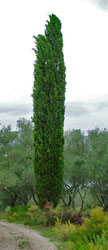 Cypress |
Cypress: - No picture of Corfu would be complete without a number of tall elegant Cypress trees scattered around the landscape. The Greeks know them as “Dachtila tou Theo” which literally means the finger of god. Every village in Corfu has its own story or superstition concerning this beautiful tree. Due to the straight growing nature of the Cypress, it was regularly used to provide the upper floors in the traditional Corfiot houses and even today is still used for roof supports and traditional boat building.
|
| Carob or Locust Tree: - This tree is evergreen and has brown broad bean like seedpods, which have been used as a substitute for chocolate and also to make carob flour, which has been used historically during times of hardship. Today it is still cultivated by some for animal fodder. The Carob seed due to its uniformity of weight has been used to measure precious items such as gemstones for thousands of years, hence the word Carat as in the measure of diamonds.
|
|
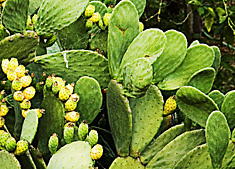 Prickly pear
|
Prickly Pear: - Christopher Columbus has been attributed with the responsibility for the introduction of Prickly Pear to the European mainland from Mexico. The Mexicans utilized the plant by cooking both leaves and fruit as a form of sustenance. Once the plant arrived in Europe it quickly spread throughout the Mediterranean, and the Venetians are thought to have introduced it to Greece where they used it as a form of natural barrier around valuable crops. In Greece the leaves have been used as fodder for animals by burning off the hard thorns and the fruit is edible and if you value your fingers is best approached by peeling with a sharp knife and fork. Be careful though as a small amount of the fruit is a cure for an upset bowel, too much fruit will only exacerbate the condition. The plant can grow up to 5 metres high and is regularly seen scattered along the roadsides and cultivated areas on Corfu. |
 Prickly juniper
|
Juniper: - A number of species of juniper can be seen on Corfu; the Prickly Juniper with its needle like leaves having two white stripes the length of the leaf. Its fruit is about 1cm. in diameter and is at first green then later turning a reddish brown. Oil extracted from the wood of the Prickly Juniper is used in the treatment of skin disorders and also in shampoo and other cosmetics. The Phoenician Juniper with its totally different leaf structure- has small scale like leaves, which cover its stems. The fruit of the Phoenician juniper are brown berries up to 14mm. In diameter. Both species can be found around Lake Korission on the south west of Corfu. |
 Pomegranate |
Other trees and shrubs, which are a common
feature of the landscape, are Holly again a remnant of the
primeval forests. Oak, a number of varieties however they
doesn’t normally attain the girth and size of Oak trees in
northern Europe. Pomegranate favoured for its fruit and
praised in many a Greek legend. Found also throughout the
island are Plane trees, Walnut, Almond, Wild Pear and
although not a tree but a grass quite large Bamboo thickets.
|
| Download PDF version of this website with more photographs etc. in the downloads section. |
|










